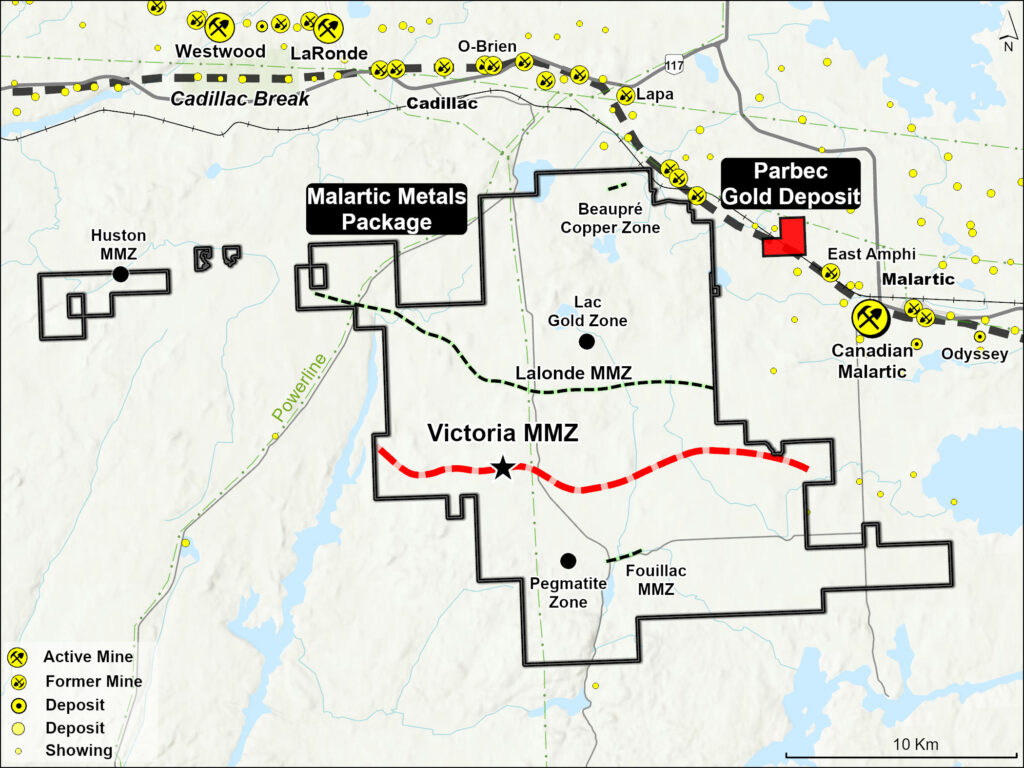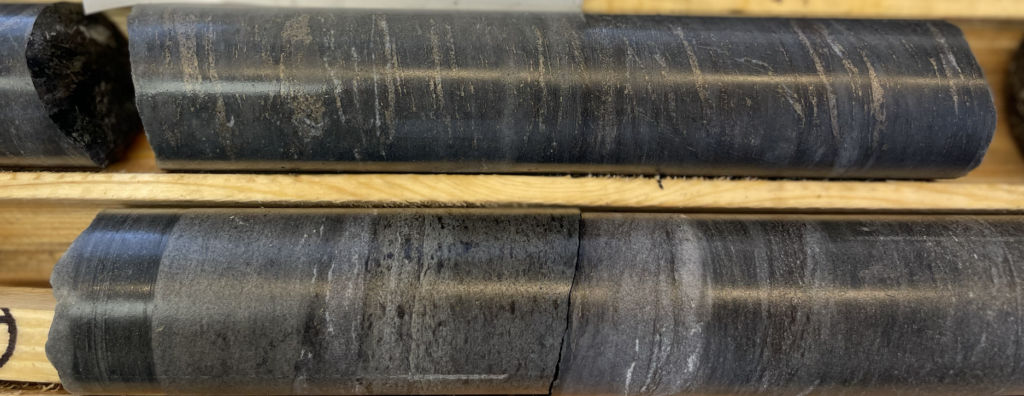Malartic Metals Package
Renforth’s wholly owned ~300 sq. km property in Quebec’s mining heartland
Surimeau’s surface mineralization includes Nickel, Zinc, Copper as well as Cobalt, Silver, Gold and Lithium in several locations

Victoria Mineralized System – Renforth’s Focus Within the Malartic Metals Packag
General model
The general Victoria model is the Pontiac sediments host a pre-existing sulphidic, graphitic horizon which bears zinc and lesser copper and perhaps cobalt. Texturally this sequence resembles an exhalite with laminated cherts and chert-sulphide layers sometimes present. Stratigraphic way-up is inferred to be northward based on scouring textures seen in SUR-21-28 and a gradual ramp-up of Pb values in country units in SUR-22-39, interpreted as the VMS hangingwall. This sequence has interacted with a series of ultramafic units (sills and/or flows) which have assimilated both sulphur and carbon from the Pontiac horizon, allowing pentlandite to be precipitated in proximity to sphalerite-pyrrhotite in places. The assimilated carbon produces a distinctive ferrodolomite contact alteration zone which is close to, or hosts, much of the mineralization.
Alternatively, pentlandite may have been generated in small amounts through the liberation of Ni during serpentinization, combining with S liberated by conversion of pyrite to pyrrhotite at amphibolite grade.
Geochemical Observations
Zinc mineralization ties very strongly to sulphidic, graphitic sedimentary units. This can be seen geochemically with a very strong zinc-copper-cobalt-sulphur correlation. Higher zinc values correlate with drops in magnesium and modest elevation in incompatible elements such as yttrium. The reduced magnesium may correlate with a possible reduction in biotite and increase in muscovite that is observed in drill core close to the mineralized zones. It is possible that the sulphidic, graphitic units are a volcanogenic exhalite and, if so, it should be possible to recognise alteration halos.
Geochemically it can be seen that the ultramafic system has two clear end-members; a mafic component that is Ni+Cr-enriched, and a komatiitic component which is both weakly Ni-enriched and partially Cr-depleted. Variolitic and spinifex textures are occasionally observed in core in the respective units. Spatially these are intricately interlayered within the Victoria belt, and some drillholes can pass through numerous stretches of each. This might suggest repeated eruptions or intrusions from a single, fractionating magma source. Each of the end-members might interact differently with the exhalite horizon and this might be an important control on nickel values. The evidence for Ni/Cr fractionation might suggest that there is potential for true magmatic or komatiitic nickel mineralization within the Victoria system, which has not yet been discovered.
Nickel correlates with sulphur within the sedimentary/exhalite units, and these samples all have extreme Ni/Cr ratios. Nickel and sulphur also weakly correlate in the mafic component of the ultramafic system, but far less so in the komatiitic component. This speaks to the deposition of nickel close to preexisting sulphur sources and the presence of some amount of sulphidic nickel within the mafic-ultramafic system. Drill logs often mention clots of graphite within the ferrodolomite-altered, nickel-mineralized portions of the mafics-ultramafics, which again supports the assimilation idea, and bolsters the case for a geophysics-based exploration strategy.
Limited PGE assaying in early 2024 revealed that elevated Pt/Pd values tended to correlate with Bi and Te far more strongly than with Ni, Co or Cu, suggesting a minor telluride component within the ultramafics.
Modelling the Mineralized Zones
Three main mineralized zones can be seen in the existing drill data. A North Contact Zone (zinc-dominated) follows the northern edge of the ultramafic belt. The South Contact Zone is mostly zinc with some nickel overprint. The Ultramafic Zone runs through the centre of the belt and is exposed in the main stripped area. This carries both nickel and zinc, and may have some amount of structural control. There are additional zinc-dominated parallel zones, particularly at the western end of current drilling, and there are some outlying high-nickel samples which might correspond to shear structures.
There may be a shallow westward plunge in the North Contact Zone. The data is less clear but there may be a similar trend in the South Contact Zone.
Geophysically it is worth noting that the mineralized zones are within the magnetic trend. This can be seen both from airborne geophysics and magnetic susceptibility, and is probably the result of pyrrhotite.
There might be patterns in the existing geophysics data that point to these hypothetical cross-cutting structures. There are low-angle embayments in the magnetic signal at Victoria which might correspond to the Ultramafic Zone and some outlying nickel-rich locations. This pattern could be applied elsewhere.
Regional Interpretation
VMS systems would be expected to form in an extensional setting with country units consisting of a mix of mafic to felsic volcanics and marine sediments. The host units are generally considered to be clastic sediments which suggests either a very immature early-stage extensional setting, or that some of the country units are not well identified. The presence of cordierite and staurolite suggests at least some phyllitic content. Further petrographic work is recommended.
Propertywide LIDAR data has recently been interpreted. Many outcrop features visible in LIDAR can be tentatively linked to the main “F1” Pontiac foliation, with two later structural deformation trends. These are best-evidenced in the northeast of Surimeau close to the Cadillac Break, but there is evidence for them from across much of the property. These deformation events may have been involved in the deposition of gold along the Cadillac Break. There might be a link between one of the trends and the Beaupré vein system.
Some of these linear trends are also present close to Victoria but their significance is not yet understood.
